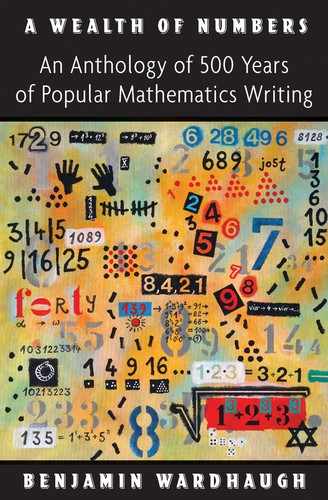Contents
![]()
1 “Sports and Pastimes, Done by Number”: Mathematical Tricks, Mathematical Games
Humfrey Baker, 1564
Henry van Etten, 1633
“How Prodigiously Numbers Do Increase”
William Leybourne, 1667
Profitable and Delightful Problems
Jacques Ozanam, 1708
L. Despiau, 1801
Dodging the Mastodon and the Plesiosaurus
Henry Ernest Dudeney, 1917
“Plenty of Interesting Things to Be Discovered”
NRICH, 1998–2004
2 “Much Necessary for All States of Men”: From Arithmetic to Algebra
Robert Recorde, 1543
Thomas Masterson, 1592
John Tapp, 1621
Edward Hatton, 1695
William Banson, 1760
Wardhaugh Thompson, 1771
Nathan Withy, 1792
Joseph Fenn, 1775
The Popular Educator, 1855
Cubic Equations for the Practical Man
J. E. Thompson, 1931
3 “A Goodly Struggle”: Problems, Puzzles, and Challenges
1798
Lydia Marie Child, 1835
1855
1874
Arthur Hirschberg, 1926
1989
4 “Drawyng, Measuring and Proporcion”: Geometry and Trigonometry
Robert Recorde, 1551
Thomas Rudd, 1650
Edmund Scarburgh, 1705
Edward Wells, 1714
Hugh Worthington, 1780
Introduction to Spherical Geometry
Horatio Nelson Robinson, 1854
Alan Clive Gardner, 1956
5 Maps, Monsters, and Riddles: The Worlds of Mathematical Popularization
1691–1697
Francesco Algarotti, 1739
W. W. Rouse Ball, 1892
Oliver Lodge, 1921
Eugene P. Northrop, 1945
Hans Rademacher and Otto Toeplitz, 1957
Dan Pedoe, 1958
Sherman K. Stein, 1963
Iakov Isaevich Khurgin, 1974
The Times, 1980
6 “To Ease and Expedite the Work”: Mathematical Instruments and How to Use Them
Martín Cortés, 1561
Thomas Fale, 1593
Seth Partridge, 1648
Telescopes Refracting and Reflecting
The Juvenile Encyclopedia, 1800–1801
J. F. Heather, 1888
Roy Worvill, 1974
Peter Duffet-Smith, 1997
7 “How Fine a Mind”: Mathematicians Past
The Labyrinth and Abyss of Infinity
Voltaire, 1733
“It Must Have Commenced with Mankind”
Charles Hutton, 1796
Kepler’s Astronomical Publications
Robert Small, 1804
Isaac Newton, a Good and Great Man
Anonymous, 1860
Thomas L. Heath, 1908
David Eugene Smith and Yoshio Mikami, 1914
“Her Absolute, Incomparable Uniqueness”
B. L. van der Waerden, 1935
“One of Your Calculating Fits”
George Bernard Shaw, 1939
Carl Boyer, 1968
Robert Kanigel, 1991
8 “By Plain and Practical Rules”: Mathematics at Work
Leonard Digges, 1579
William Hunt, 1673
John Love, 1688
Archibald Patoun, 1762
William Templeton, 1833
Lucius D. Gould, 1853
William H. Dooley, 1920
Samuel Slade and Louis Margolis, 1941
9 “The Speedier Expedition of Their Learning”: Thoughts on Teaching and Learning Mathematics
“To Have Their Children or Servants Instructed”
Humfrey Baker, 1590
Isaac Barrow, 1660
Leonhard Euler, 1760
“Mrs Lovechild,” 1785
Catherine Vale Whitwell, 1823
Thomas Perronet Thompson, 1833
Lewis Carroll, 1887
Mrs. Henry Sidgwick, 1912
A New Aspect of Mathematical Method
George Pólya, 1945
Evelyn Sharp, 1966
“Merely a Formal Statement of the Way We Think”
Robert E. Eicholz and Phares G. O’Daffer, 1964
Serafim Gascoigne, 1985
10 “So Fundamentally Useful a Science”: Reflections on Mathematics and Its Place in the World
Gossuin of Metz, 1481
John Dee, 1570
Joseph Glanvill, 1664
Edmund Scarburgh, 1705
Richard Sault, 1710
William Playfair, 1798
Charles Stargard Rumker, 1825
William Barnes, 1834
J. J. Sylvester, 1870
What a Mathematical Proposition Is
Cassius Jackson Keyser, 1929
Richard P. Feynman, 1965
Allen L. Hammond, 1978
11 The Mathematicians Who Never Were: Fiction and Humor
Margaret Cavendish, 1666
“Captain Gulliver,” 1727
John Kirkby, 1745
John Frere, 1798
William Combe, 1815
Alfred Domett, 1833
Augusta Jane Evans, 1864
1863, 1870
Edwin A. Abbott, 1884
Scenes in the Life of Pythagoras
Geoffrey Willans and Ronald Searle, 1953
Kim Stanley Robinson, 1996
